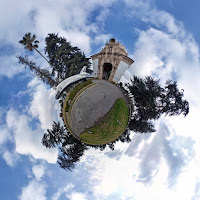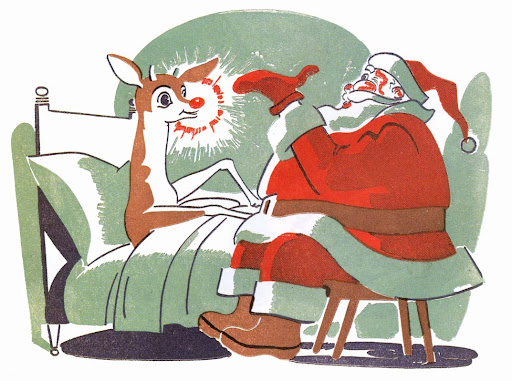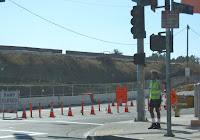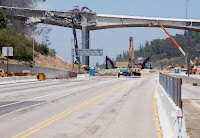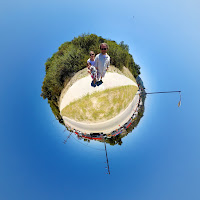View on Google Maps Street View
A year ago I blogged about my New Year’s goal to develop my chops in 360° photography. To that end, throughout the 2011 I explored and photographed spaces that artist’s work in and/or find inspirational.
This brought me to Salvation Mountain on Easter Sunday where not only did I meet the artist Leonard Knight (see original post) but also had a star sighting: Sean Penn and his gal pal Scarlett Johanssen. Knight appeared as a cameo in the film “Into the Wild” (2007) that was directed by Penn. It would appear that since then they’ve remained friends.
When in early December Knight was placed in a home after being diagnosed with dementia, I became concerned about the survival of his life’s work. In my humble opinion, without the artist there to maintain it, it wouldn’t be long before the mountain suffers from either erosion or vandalism or both.
 |
| Salvation Mountain – “Little Planet” projection |
So I made plans to camp at Salvation Mountain for New Years and take some panorama photos for posterity. The first time I came to visit the weather was warm but blustery winds whirled around the mountain which limited my ability to interior shots only.
This time, however, the weather conditions were more favorable: the air was calm and still which enabled me to get a series of exterior shots that I’ve posted below.
Salvation Mountain gives curb appeal to the community of people who live in what’s called Slab City, an abandoned Marine base in the Salton Sea that’s been overtaken by squatters for the past 50 years or so. You could say the mountain is the crown jewel of the slabs.
Recently there’s been a lot of press about Slab City* that’s mostly tied to Knight’s health reports and the fate of Salvation Mountain. This has caught the attention of many journalists (of which I met several on this recent trip) that have discovered that Slab City’s inhabitants to be rich with human interest stories about outsider artists as well as survivors of the Econopocalypse.
I should say that “slabbers“, as the locals like to refer themselves to, consists of folks living on the edge: a weird hybrid of retired fixed income senior citizens and wealthy snowbirds, homeless vagabonds, itinerant Canadians (!), dirty hippies, children of the Rainbow Family and binky sucking candy ravers, not to mention runaways, alcoholics, tweekers and dropouts.
It’s not exactly a tourist destination to go to Slab City. It’s not even remotely like a family vacation at Disneyland or even Burning Man. No, Slab City is rough yet some inhabitants have brought their families there presumably because they have no place else to go. A visit to the slabs is like entering the world of Mad Max where all the perceived danger is real. It’s no place for kids. That said, most of the locals I met were incredibly kind, genuine and authentic. I even met a bunch of out-of-towners like myself including a slew of hipsters from San Francisco, a contingent of Tucsonian students, and some German and Australian tourists. Of course, academia also represented: I met a sociolologist from Stanford documenting the slabbers and their urban tribal community.
While I befriended many slabbers that I consider to be the salt of the earth, I also found that a few of Slab City’s inhabitants — to quote Obi Wan Kenobi — can be described as wretched and well, downright scummy. One must be cautious when visiting this place. If you’re thinking of visiting put your trust to the tender mercies of a man named James, a long-time slabber with the world’s smartest and cutest dog called “Spider Monkey” and tell him I sent you.
If you prefer to visit the slabs through the magic of technology, you can catch James tonight at 10pm on the History Channel: Corey’s Big Play. (2012). https://www.history.com/shows/pawn-stars/episodes/current-season. And you can always virtually visit Salvation Mountain through the series of 360° panoramas I took by clicking on the images below:
 |
| Entrance to Salvation Mountain |
 |
| Parking lot of Salvation Mountain |
 |
| Leonard Knight’s “Yellow Brick Road” |
 |
| The Gates of Love at Salvation Mountain |
 |
| North side of Salvation Mountain |
 |
| Salvation Mountain from the road |
 |
| Interior, Salvation Mountain |
* Slab City: Last free place in America? Imperial Valley Press, December 31, 2011
All directions point to East Jesus, Imperial Valley Press, December 31, 2011
Hard Times on Salvation Mountain, KCET, December 20, 2011
The Future Of Salvation Mountain Uncertain, KPBS, December 20, 2011
A 24 Hour Visit To Slab City…, Seattle Post Intelligencer, December 20, 2011
Living off the grid in Slab City, Los Angeles Times, December 19, 2011
Slab City, a trailer park utopia, thrives in remote desert – Los Angeles Times – December 17, 2011
“Slab City” a desert haven for recession’s victims, CBS News – December 14, 2011



